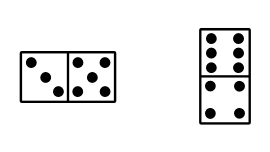Dominoes in Unicode
I was spelunking around in Unicode and found that there are assigned characters for representing domino tiles and that the characters are enumerated in a convenient order. Here is the code chart.
There are codes for representing tiles horizontally or vertically. And even though, for example, the 5-3 is the same domino as the 3-5, there are separate characters for representing the orientation of the tile: one for 3 on the left and one for 5 on the left.
When you include orientation like this, a domino becomes essentially a base 7 number: the number of spots on one end is the number of 7s and the number of spots on the other end is the number of 1s. And the order of the characters corresponds to the order as base 7 numbers:
0-0, 0-1, 0-2, ..., 1-0, 1-1, 1-2, ... 6-6.
The horizontal dominoes start with the double blank at U+1F031 and the vertical dominoes start with U+1F063, a difference of 32 in hexadecimal or 50 in base 10. So you can rotate a domino tile by adding or subtracting 50 to its code point.
The following tiny Python function gives the codepoint for the domino with a spots on the left (or top) and b spots on the right (or bottom).
def code(a, b, wide): cp = 0x1f031 if wide else 0x1f063 return cp + 7*a + b
We can use this function to print a (3, 5) tile horizontally and a (6, 4) tile vertically.
print( chr(code(3, 5, True )), chr(code(6, 4, False)) )
To my surprise, my computer had the fonts installed to display the results. This isn't guaranteed for such high Unicode values.
